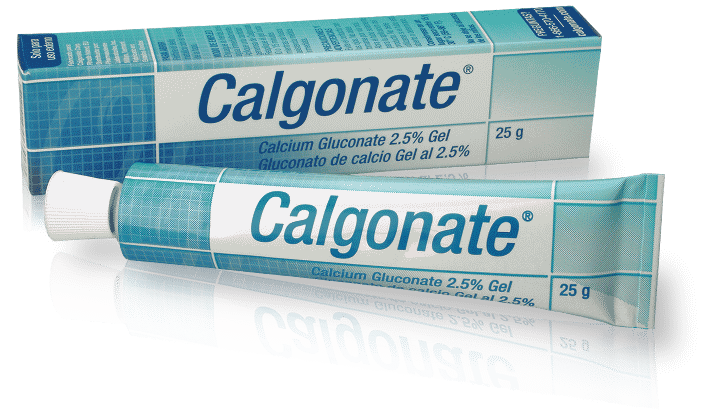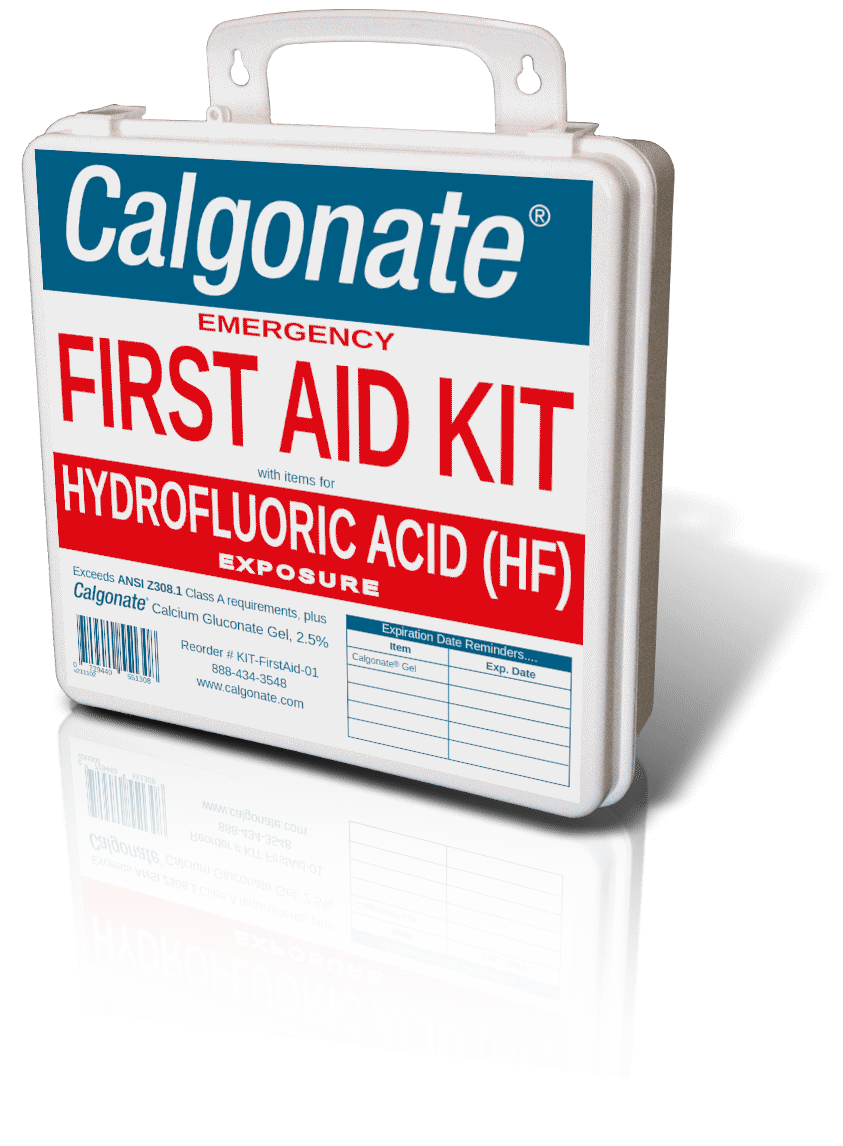Frequently Asked Questions
- What is Calgonate® Gel?
- How does Calgonate® Gel help with HF exposure?
- Who should stock Calgonate® Gel?
- Do I need a prescription to purchase Calgonate® products?
- What should I do if HF comes into contact with my body?
- Should I use Calgonate® Gel if HF comes in contact with my eyes?
- Is Calgonate® Gel FDA approved?
- Glossary of Terms
What is Calgonate® Gel?
Calgonate® Gel is an effective topical 2.5% calcium gluconate gel used in first aid response when hydrofluoric acid (HF) contacts the body.

How does Calgonate® Gel help with HF exposure?
The gel does NOT treat or heal HF burns. Calcium gluconate combines with hydrofluoric acid to neutralize HF's powerful fluoride ion. This helps stop it before it can penetrate into tissue and bone and do damage. This is why Calgonate® Gel should be used as soon as HF exposure is suspected, don't wait to see if burn symptoms develop!

Who should stock Calgonate® Calcium Gluconate Gel?
• People who work with hydrofluoric acid should carry the convenient 25g tube in their pocket.
• People who transport or store HF in their facilities should include tubes of the gel in first-aid kits.
• People who may respond to HF accident/burn victims should stock the gel.

Do I need a prescription to purchase Calgonate® products?
No.

What should I do if HF comes into contact with my body?
It is important for you to develop your own policy and procedures for dealing with HF accidents at your facility. Steps that are often found in published policies for responding to HF contact with skin include:
• Immediately wash/flush the area well with water.
• Generously apply Calgonate® gel to the affected area.
• Seek immediate medical attention as soon as these initial first-aid procedures have begun.
Your procedure should also strive to avoid secondary HF exposure to the victim or any person giving assistance (by touching contaminated skin, clothing, equipment, or even the gel tube after first used).

Should I use Calgonate® Gel if HF comes in contact with my eyes?
Do not apply Calgonate® 2.5% Calcium Gluconate Gel to the eyes. A 1% solution of calcium gluconate is recommended if HF comes into contact with your eyes.

Is Calgonate® Gel FDA approved?
Calgonate® Gel has not been evaluated by the Food and Drug Administration.

Glossary of terms

Antidote
A remedy or other agent used to neutralize or counteract the effects of a poison.

Contra-indications
A factor that renders the administration of a drug or the carrying out of a medical procedure inadvisable.

Corneal
Of or relating to the cornea, the transparent part of the coat of the eyeball that covers the iris and pupil and admits light to the interior.

Edema
An excessive accumulation of serous fluid in tissue spaces or a body cavity.

Emetics
An agent or substance that causes vomiting.

Fluorosis
An abnormal condition (as mottled enamel of human teeth) caused by fluorine or its compounds.

Hypocalcemia
An abnormally low concentration of calcium in the blood.

Ingestion
The taking of material (as food) into the digestive system.

Inhalation
The act or an instance of inhaling; specifically : the action of drawing air into the lungs by means of a complex of essentially reflex actions that involve changes in the diaphragm and in muscles of the abdomen and thorax which cause enlargement of the chest cavity and lungs resulting in production of relatively negative pressure within the lungs so that air flows in until the pressure is restored to equality with that of the atmosphere.

Inflammation
A local response to cellular injury that is marked by capillary dilatation, leukocytic infiltration, redness, heat, pain, swelling, and often loss of function and that serves as a mechanism initiating the elimination of noxious agents and of damaged tissue.

Irritation
Soreness, roughness, or inflammation of a bodily part.

Miscible
Capable of being mixed; specifically : capable of mixing in any ratio without separation of two phases <miscible liquids>

Mylanta®
Used as an antacid and antiflatulent; preparation of aluminum hydroxide, magnesium hydroxide, and simethicone.

Nebulized
To convert (a liquid) to a fine spray; atomize.

Pulmonary
Relating to, functioning like, associated with, or carried on by the lungs.

Pulmonary Edema
Abnormal accumulation of fluid in the lungs

Respiration
1: a. the placing of air or dissolved gases in intimate contact with the circulating medium (as blood) of a multicellular organism (as by breathing) b. a single complete act of breathing <30 respirations per minute> 2: the physical and chemical processes by which an organism supplies its cells and tissues with the oxygen needed for metabolism and relieves them of the carbon dioxide formed in energy-producing reactions

Respiratory
Of, relating to, used in, or affecting respiration.

Sterile
Free from living organisms and especially microorganisms <a sterile cyst>

Stimulant
An agent, especially a chemical agent such as caffeine or alcohol that temporarily arouses or accelerates physiological or organic activity.

Systemic
Of, relating to, or common to a system: as a: affecting the body generally —compare LOCAL b: supplying those parts of the body that receive blood through the aorta rather than through the pulmonary artery c: being a pesticide that as used is harmless to a higher animal or a plant but when absorbed into the bloodstream or the sap makes the whole organism toxic to pests (as cattle grubs, mites, or aphids).

Topical
Pertaining to, or applied externally to, a particular part of the body.

Viscous
1: having a glutinous consistency and the quality
of sticking or adhering : VISCID
2 : having or characterized by viscosity <a
viscous flow>



























